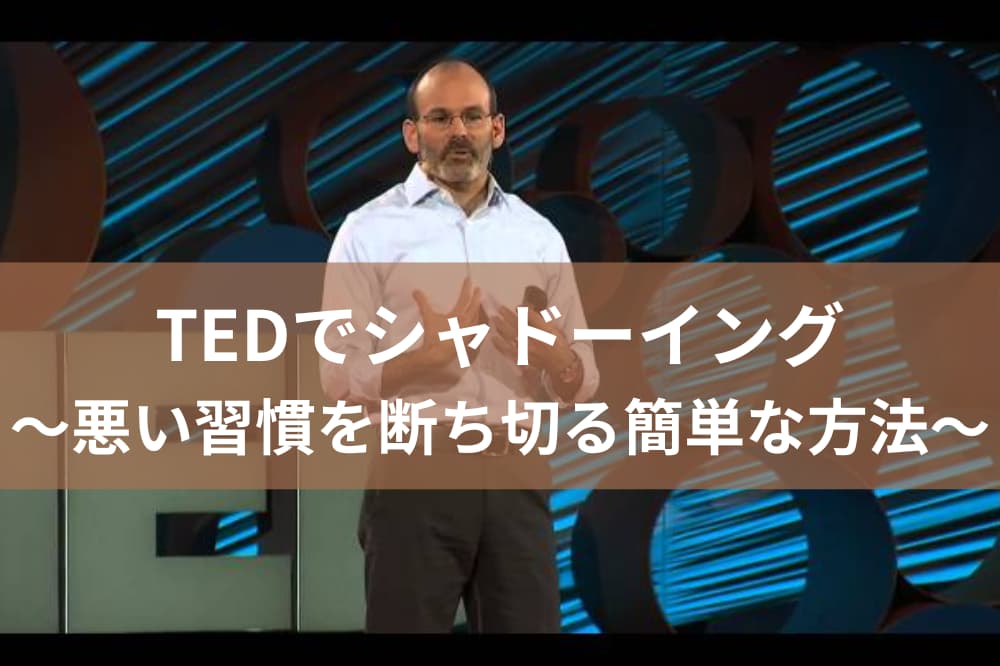
TEDでシャドーイングの勉強をしたい
日本語字幕と英語字幕を同時に見ながらシャドーイングしたい
Youtubeでは字幕の進むスピードが早すぎる

日本語字幕と英語字幕を交互に並べて、自分のスピードで確認しながらYoutubeのTEDで英語学習できる記事を作成しました。
こんにちは。
今回はYoutubeのTEDを利用してシャドーイングをしたい方向けに、日本語和訳と英語字幕を並べた記事を作成しました。
Youtubeを見ながらシャドーイングする際、動画に映すことができるのは英語字幕か日本語字幕のどちらかです。わからない単語の意味を確認したいときに、いちいち止めて調べるのは少し面倒ですよね。
そんなシャドーイング初心者のために、英語字幕と日本語和訳を交互に並べた記事を作成しました。
動画の音声を聞きながら、自分のタイミングでスクロールしながら英語とその意味を確認できます。
もしこの記事をパソコンでみている方がいらっしゃれば、動画の途中でスペースキー、もしくはKを押すと一時停止、Lを押すと10秒進む、Jを押すと10秒戻ります。
下の方にスクロールした際には、こちらのショートカットキーを覚えておくととても便利です。
シャドーイングの練習に役立てていただけると幸いです。
悪い習慣を断ち切る簡単な方法 〜A simple way to break a bad habit / Judson Brewer〜
(00:13) When I was first learning to meditate, the instruction was to simply pay attention to my breath, and when my mind wandered, to bring it back.
私が瞑想を習い始めたとき 指示はこんな簡単なものでした 「呼吸を意識しましょう 雑念が浮かんだら 呼吸に意識を戻しましょう」
Sounded simple enough. Yet I’d sit on these silent retreats, sweating through T-shirts in the middle of winter.
そのくらい簡単だと思いました でも実際に 瞑想の合宿研修で 座禅を組んでみると 真冬なのにTシャツ1枚で 汗だくになりました
I’d take naps every chance I got because it was really hard work.
時間を見つけては 昼寝をしました 結構疲れるからです
Actually, it was exhausting. The instruction was simple enough but I was missing something really important.
実際 体力がもちませんでした 簡単な指示にもかかわらず 私には 肝心な何かが つかめていなかったのです
So why is it so hard to pay attention? Well, studies show that even when we’re really trying to pay attention to something — like maybe this talk — at some point, about half of us will drift off into a daydream, or have this urge to check our Twitter feed.
注意を保つのは なぜ こんなに難しいのでしょう? いくつかの研究によると 一生懸命 何かに集中しようとしても 例えば このトークを聞くにしても ある時点から 半分ぐらいの人が 上の空になったり Twitterを見たくなったりするそうです
So what’s going on here? It turns out that we’re fighting one of the most evolutionarily-conserved learning processes currently known in science, one that’s conserved back to the most basic nervous systems known to man.
なぜ こうなるのでしょう? 実は こんなとき人は 現在知られている学習プロセスの中で 最も原始的なものの 1つと戦っています
This reward-based learning process is called positive and negative reinforcement, and basically goes like this.
最も基本的だと 研究からわかっている神経系に 刻み込まれたプロセスです これは報酬に基づく学習プロセスで 「正の強化」および「負の強化」と呼ばれ 基本はこんな仕組みです
We see some food that looks good, our brain says, “Calories! … Survival!” We eat the food, we taste it — it tastes good.
例えばおいしそうな食べ物を見ると 「カロリーだ! 食べて生き残れ!」と 脳は命じます そして口に入れ 味わい おいしさに満足します
And especially with sugar, our bodies send a signal to our brain that says, “Remember what you’re eating and where you found it.”
特に砂糖が入っていると 体から脳へ こんな信号が送られます 「今 食べたものと どこで見つけたかを記憶せよ」
We lay down this context-dependent memory and learn to repeat the process next time.
私たちはこれを「文脈依存記憶」として 脳内にとどめて そのプロセスを次回も繰り返すことを 学習します
See food, eat food, feel good, repeat. Trigger, behavior, reward. Simple, right?
食べ物を見る 食べる そしていい気分になる 繰り返す トリガー(きっかけ)→行動→報酬 簡単ですね
Well, after a while, our creative brains say, “You know what? You can use this for more than just remembering where food is. You know, next time you feel bad, why don’t you try eating something good so you’ll feel better?”
やがて 独創的な脳はこう思い付きます 「なあ ちょっと 単純に 食べ物の在りかを 覚えとくだけじゃなく 今度 気分が落ち込んだとき 何か食べてみたら 気分がよくなるんじゃないか?」と
We thank our brains for the great idea, try this and quickly learn that if we eat chocolate or ice cream when we’re mad or sad, we feel better.
それを 私たちは脳に言われるがまま実行し その結果を覚えてしまいます 悲しいときや頭にきたとき チョコレートやアイスクリームを食べると 気が紛れますよね
Same process, just a different trigger. Instead of this hunger signal coming from our stomach, this emotional signal — feeling sad — triggers that urge to eat.
これも 同じプロセスです トリガーが違うだけ 胃から発せられる 空腹のシグナルではなく 感情のシグナル つまり「悲しみ」が 食欲のトリガーとなるのです
Maybe in our teenage years, we were a nerd at school, and we see those rebel kids outside smoking and we think, “Hey, I want to be cool.
例えば 私らが10代の頃 学校では「オタク」だったのが 外ではワルぶって 喫煙してる連中がいたのを 「カッコイイ」と思って 自分もマネしてみたとか
” So we start smoking. The Marlboro Man wasn’t a dork, and that was no accident.
タバコ広告のモデルが本当にカッコいい 時代もありましたからね
See cool, smoke to be cool, feel good. Repeat. Trigger, behavior, reward.
カッコいい姿を見る カッコよくなるために吸う いい気分になる だから繰り返す これも「トリガー→行動→報酬」です
And each time we do this, we learn to repeat the process and it becomes a habit.
これを実行するたびに 同じプロセスを繰り返して学習し これが 習慣になります
So later, feeling stressed out triggers that urge to smoke a cigarette or to eat something sweet.
こうして 強いストレスが トリガーとなり タバコが吸いたくてたまらなくなったり 甘いものが欲しくなったりします
Now, with these same brain processes, we’ve gone from learning to survive to literally killing ourselves with these habits.
一方 脳の同じプロセスによって 生き延びるための学習が 悪習と化し 文字どおり 自殺行為となってしまっています
Obesity and smoking are among the leading preventable causes of morbidity and mortality in the world.
例えば肥満や喫煙は 世界の罹患・死亡要因の中でも 回避できるものの代表的な例です
So back to my breath. What if instead of fighting our brains, or trying to force ourselves to pay attention, we instead tapped into this natural, reward-based learning process …
呼吸の話に戻りますが 自分の脳に抵抗したり
but added a twist? What if instead we just got really curious about what was happening in our momentary experience?
無理に何かに意識を向けようとする代わりに 「報酬に基づく学習プロセス」を 活用してみるのはどうでしょう コツがあるんですよ
I’ll give you an example. In my lab, we studied whether mindfulness training could help people quit smoking.
例を挙げますね 私の研究室では マインドフルネス・トレーニングが 禁煙に有効かどうかを研究しました
Now, just like trying to force myself to pay attention to my breath, they could try to force themselves to quit smoking.
私が無理して呼吸に意識を 向けようとしたのと同じように 無理やり喫煙の習慣を断とうとする というやり方もありました
And the majority of them had tried this before and failed — on average, six times.
参加者の大半はそうやって禁煙を試み 挫折を経験した人でした 平均6回失敗していました
Now, with mindfulness training, we dropped the bit about forcing and instead focused on being curious.
でも このトレーニングでは 参加者に何かを強制するのではなく 好奇心を持つように促しました
In fact, we even told them to smoke.
実際 喫煙を勧めさえしました
What? Yeah, we said, “Go ahead and smoke, just be really curious about what it’s like when you do.”
本当です 「どうぞ吸ってください どんな気分になるか 関心を持って観察してみてください」と
And what did they notice?
さて その結果は?
Well here’s an example from one of our smokers.
ある参加者のコメントを紹介します
She said, “Mindful smoking: smells like stinky cheese and tastes like chemicals, YUCK!”
「マインドフルネス喫煙は 臭いチーズみたいなニオイで 薬臭い味だった オエッ!」
Now, she knew, cognitively that smoking was bad for her, that’s why she joined our program.
彼女はもともと 喫煙が良くないという 認識があったからこそ 私たちのプログラムに参加したわけです
What she discovered just by being curiously aware when she smoked was that smoking tastes like shit.
そんな彼女が 喫煙したときの感覚に 興味を持つことで発見したのは 「タバコはクソまずい」ってことでした
(Laughter)
(笑)
Now, she moved from knowledge to wisdom.
こうして彼女の中で 知識が知恵に変わりました
She moved from knowing in her head that smoking was bad for her to knowing it in her bones, and the spell of smoking was broken.
「喫煙は良くない」と 頭で理解しているだけの段階を抜けて つくづく 骨身に染みたので 喫煙の魔法は解けました
She started to become disenchanted with her behavior.
タバコを吸うという自分の行為に 幻滅するようになったんです
Now, the prefrontal cortex, that youngest part of our brain from an evolutionary perspective, it understands on an intellectual level that we shouldn’t smoke.
このとき 前頭前野は ここは脳の進化の過程では 最後に生まれた部分ですが 知能の域では 喫煙すべきではないと理解しています
And it tries its hardest to help us change our behavior, to help us stop smoking, to help us stop eating that second, that third, that fourth cookie.
そんな前頭前野は 一生懸命 人が行動を変えられるよう つまり喫煙をやめたり 2つ目 3つ目 4つ目のクッキーには 手を出さないように助けようとします
We call this cognitive control.
「認知的制御」というものです
We’re using cognition to control our behavior.
人間は 行動を制御するために 認知を使うんです
Unfortunately, this is also the first part of our brain that goes offline when we get stressed out, which isn’t that helpful.
しかし 残念なことに この前頭前野は 強いストレスを受けると 働かなくなってしまうので それほど役に立ちません
Now, we can all relate to this in our own experience.
これは皆さんも日常で 経験していることでしょう
We’re much more likely to do things like yell at our spouse or kids when we’re stressed out or tired, even though we know it’s not going to be helpful.
配偶者や子どもに つい怒鳴ってしまうこと ありますよね
We just can’t help ourselves.
ストレスや疲れがたまっていると そんなことしても意味がないと 分かっていても 自分が抑えられなくなります
When the prefrontal cortex goes offline, we fall back into our old habits, which is why this disenchantment is so important.
前頭前野が働かなくなると 昔ながらの習慣に逆戻りしてしまいます 自分自身の行為への幻滅が重要な理由は ここにあります
Seeing what we get from our habits helps us understand them at a deeper level — to know it in our bones so we don’t have to force ourselves to hold back or restrain ourselves from behavior.
習慣に従った結果を見つめることで 骨身に染みるほど深いレベルで 悪習の実態を自覚できます こうすると 行動を無理に抑えたり 我慢したりすることもなくなります
We’re just less interested in doing it in the first place.
そもそも その行為自体への興味が 薄まるからです
And this is what mindfulness is all about:
これがマインドフルネスの神髄です
Seeing really clearly what we get when we get caught up in our behaviors, becoming disenchanted on a visceral level and from this disenchanted stance, naturally letting go.
悪習にとらわれた結果を 客観的に見据え 心底 嫌気がさすことで 昔の悪い習慣から自然に 離れることができるんです
This isn’t to say that, poof, magically we quit smoking.
魔法のように 一瞬にして 禁煙できるわけではないですが
But over time, as we learn to see more and more clearly the results of our actions, we let go of old habits and form new ones.
時間をかけて 少しずつ 自分の行動の結果への 自覚が深まるにつれ 自然に昔の習慣が離れていき 新しい習慣が形成されます
The paradox here is that mindfulness is just about being really interested in getting close and personal with what’s actually happening in our bodies and minds from moment to moment.
ただし 矛盾があるんです マインドフルネスで大事なのは 関心を向けることです 移り行く一瞬一瞬の中で 自分の体と心に起こることのすべてを 敏感に感じ取ろうとすることです
This willingness to turn toward our experience rather than trying to make unpleasant cravings go away as quickly as possible.
良からぬ欲望を遠ざけようと焦るよりも
And this willingness to turn toward our experience is supported by curiosity, which is naturally rewarding.
自分自身の体験に意識を 向けようとする意欲— つまりこの 体験に意識を向ける意欲の 土台となっている好奇心には 満足感をもたらす性質があります
What does curiosity feel like? It feels good.
好奇心って いい気分ですよね
And what happens when we get curious?
好奇心を持つと 人はどうなるでしょうか?
We start to notice that cravings are simply made up of body sensations — oh, there’s tightness, there’s tension, there’s restlessness — and that these body sensations come and go.
欲求の正体は身体感覚に過ぎないと 気づけるようになります つまり緊張や不安感 そわそわ感などです この身体感覚は 現れたり消えたりします
These are bite-size pieces of experiences that we can manage from moment to moment rather than getting clobbered by this huge, scary craving that we choke on.
自分の中で起きる 小さな体験であり そのつど 自分で制御することも可能です 私たちを苦しめる 巨大で恐ろしい欲求に やられっぱなしにはなりません
In other words, when we get curious, we step out of our old, fear-based, reactive habit patterns, and we step into being.
言い換えると 好奇心を持つことで 長年染み付いた 不安から来る 反射的な習慣行動から抜け出して あるがままの自分を 認められるようになります
We become this inner scientist where we’re eagerly awaiting that next data point.
自分の内面に科学者が誕生し 次のデータ点はどこだろうと 心待ちにするようになります
Now, this might sound too simplistic to affect behavior.
行動を変える方法として 安易すぎるように聞こえるかもしれませんが
But in one study, we found that mindfulness training was twice as good as gold standard therapy at helping people quit smoking.
ある研究で マインドフルネスのトレーニングは 標準的な治療法に比べ 禁煙に 2倍の効果があると分かりました
So it actually works.
実際に効き目があるわけです
And when we studied the brains of experienced meditators, we found that parts of a neural network of self-referential processing called the default mode network were at play.
また 瞑想の達人の脳を調べたところ 神経網の一部の 自己参照処理機能である— デフォルトモードネットワーク(DMN) が活性化していました
Now, one current hypothesis is that a region of this network, called the posterior cingulate cortex, is activated not necessarily by craving itself but when we get caught up in it, when we get sucked in, and it takes us for a ride. In contrast, when we let go — step out of the process just by being curiously aware of what’s happening — this same brain region quiets down.
現存する仮説によると DMNの一部の領域である― 後帯状皮質と呼ばれる部分は 必ずしも 人が強い欲求を 抱いたときではなく 欲求にとらわれているときに 活性化するため 私たちはこれにだまされるそうです 逆に その衝動から距離を置いて 自分に起こっている変化を ただ注意深く観察することで プロセスから抜け出せば 後帯状皮質の興奮は収まります
Now we’re testing app and online-based mindfulness training programs that target these core mechanisms and, ironically, use the same technology that’s driving us to distraction to help us step out of our unhealthy habit patterns of smoking, of stress eating and other addictive behaviors. Now, remember that bit about context-dependent memory? We can deliver these tools to peoples’ fingertips in the contexts that matter most.
さて現在 マインドフルネスを教える オンラインコースとアプリを試験運用中です これは 今お話しした脳のメカニズムに 働きかけて 皮肉にも 人々を 現実逃避に駆り立てている技術を活用して 不健康な習慣から抜け出すのに 役立てるというものです 例えば喫煙 ストレスからの過食 その他の依存的な習慣を断つためです 先ほど話した「文脈依存記憶」を 覚えていますか? このツールは その人にとって 一番大事な「文脈」で すぐに使えます
So we can help them tap into their inherent capacity to be curiously aware right when that urge to smoke or stress eat or whatever arises.
つまり 人々が タバコの誘惑を感じたり ヤケ食いしたい衝動が起こったその場で 脳に本来備わる 注意深く意識する能力を 利用するのに役立てられるのです
So if you don’t smoke or stress eat, maybe the next time you feel this urge to check your email when you’re bored, or you’re trying to distract yourself from work, or maybe to compulsively respond to that text message when you’re driving, see if you can tap into this natural capacity, just be curiously aware of what’s happening in your body and mind in that moment.
喫煙やヤケ食いをしない人でも 暇つぶしに メールをチェックしたくなったり 仕事中に無関係なことを始めたくなったり 車を運転している最中に メールの返事をしたい衝動に駆られたりしたら 脳の本来の性質をうまく利用できるか 試してみてください ただ好奇心を持ち その瞬間 体と心に起こっていることを 観察してみてください
It will just be another chance to perpetuate one of our endless and exhaustive habit loops … or step out of it.
これはチャンスです 終わりがなく 疲れるだけの悪循環に 一生付き合うか― 断ち切るかの分かれ道です
Instead of see text message, compulsively text back, feel a little bit better — notice the urge, get curious, feel the joy of letting go and repeat.
メールが来たら 反射的に 返信するのではなく 向き合い方を変えましょう 衝動に気づいて それに関心を持ち 手放す喜びを感じてください これを繰り返しましょう
Thank you. (Applause)
ありがとうございました (拍手)
まとめ
このほかにも、TEDでシャドーイングの練習ができる記事をまとめました。
こちらも合わせて見ていただけますと幸いです。
それではまた。




コメント